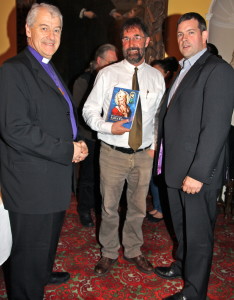
By Sarah Mac Donald - 27 October, 2013
The Anglican Primate of Ireland has warned Irish society that it must avoid “capitulating to caricatures” on any ethnic group.
Archbishop Michael Jackson of Dublin and Glendalough was responding to questions from CatholicIreland.net about migration into Ireland and the recent treatment of two Roma families and their children by the Gardaí and HSE.
“I think this genuinely is a cringe moment – the test of it is can we learn from it,” he said.
The Archbishop said that the most “alarming” aspect of the two Roma cases was the fact that “a child was at the heart” of events.
“I think that those, who in good faith, exercise and execute public policy need to be careful of the damage which can be done in error – even more than by design – to children who find themselves pawns in a media world,” he commented.
Dr Jackson called for careful checking of lines of inquiry and facts as well as a realisation that “what may look as if it is impossible is actually real.”
However, he also acknowledged that statutory bodies had no option but to investigate an allegation. He said he had “tremendous sympathy” for the state bodies tasked with dealing with allegations.
“Those statutory bodies have no option but to investigate, they have to do things by the book. But objective documentation is always important in such a context,” he suggested. He also warned that the difficulty sometimes lay in the intention of those making an allegation.
The Archbishop also admitted that the Church of Ireland needs to be more welcoming towards new members who can sometimes find it difficult to become part of the Church’s decision-making structures.
He suggested that the difficulty could be a community whose identity was “bound up with its survival rather than its creativity.” He said that new members, be they immigrants to Ireland or former members of the Roman Catholic, Lutheran or Presbyterian Churches, “deserve a welcome.”
He was speaking after he launched a new book on St Patrick which suggests that the country’s patron saint hailed from Brittany and not Britain. In a tribute, Archbishop Jackson described the author, Reverend Marcus Losack, as a friend of long standing who is no new comer to St Patrick.
“He has devoted much of his ordained life to pilgrimage in Ireland and abroad. We are the richer for this commitment,” he said.
Referring to Rev Losack’s choice of St Patrick’s Cathedral and its Deanery as the place for the launch, the Archbishop noted that he dedicated his book to John Victor Luce, a former Professor of Classics in Trinity College Dublin, and one of the Archbishop’s own teachers. John Victor Luce’s father AA Luce was Regius Professor of Divinity and a canon of St Patrick’s Cathedral.
Thanking the present Dean, the Very Rev Victor Stacey, for his generous hospitality in hosting the launch, Archbishop Jackson said St Patrick’s “seeks to live out generous Anglicanism for all without distinction or discrimination, whether we live in Dublin or visit from anywhere across the inhabited world.”
He added, “The welcome is consistently the same and the sense of pilgrimage and arrival in this beautiful medieval space is significant.”

The Church of Ireland Archbishop of Dublin, the Most Revd Dr Michael Jackson, Rev Marcus Losack and Fergal O’Boyle of Columba Press at the launch of ‘Rediscovering Saint Patrick: A New Theory of Origins’ in the Deanery of St Patrick’s Cathedral, Dublin.
He described ‘Rediscovering Saint Patrick’ as a painstaking examination of manuscripts, of geographies, of families which led to a range of conclusions which add freshness and vitality to the well-worked subject of St Patrick.
“It leads to a most exciting conclusion to the effect that older history serves the needs of newer history and, in finding fresh prominence, gives itself a new purpose. I often say the following: Tradition is the church interpreting, not the church reminiscing,” he said.
Among the guests attending the launch of ‘Rediscovering Saint Patrick: A New Theory of Origins’ were Patrick Loisel and his wife Isabel.
They travelled from France specially to attend the launch as representatives the Breton villagers around Chateau de Bonaban near St Malo, which is believed to be the location of Patrick’s home before he was kidnapped by Irish pirates in the 5th century.
Patrick Loisel explained to CatholicIreland.net how forty years ago he read the monograph by Joseph Viel titled ‘La Gouesnière et Bonaban’ which on pp116-117 of his edition links St Patrick’s origins with Bonaban. “Joseph Viel was my grandfather’s teacher,” he said.
He explained that many people did not believe the claim made by Joseph Viel about St Patrick and that was why he was so pleased by Rev Losack’s research and suggestion that the Bonaban connection could be right. “When I read Marcus’ book I was so happy”, he said. Patrick Loisel was the first person to purchase a copy of the book online.
He is part of a committee in the Breton village which would like to see an archaeological dig carried out at Chateau de Bonaban which may verify the claims made in Rev Losack’s book.
“I tried last year and this year to spread the news around me [about the new theory of St Patrick’s origins] but it is difficult. The impact of St Patrick’s story in Brittany is not the same as it is here. But I want to work together on that with Marcus Losack,” he said.
Singer and harpist Claire Roche provided music for the evening using two harps, one a traditional Irish harp and another which is a French small concert harp, echoing the theme of the book and the evening. One of the songs she preformed was ‘St Patrick’s Breastplate’.